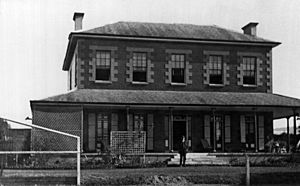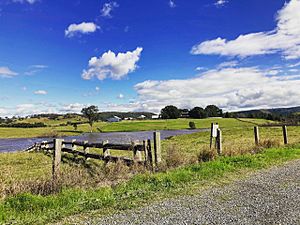Tocal Homestead facts for kids
Quick facts for kids Tocal Homestead |
|
|---|---|
 |
|
| Location | Tocal Road, Paterson, Dungog Shire, New South Wales, Australia |
| Built | 1822–1922 |
| Architect |
|
| Owner | C.B. Alexander Foundation |
| Official name: Tocal Homestead | |
| Type | State heritage (complex / group) |
| Designated | 2 April 1999 |
| Reference no. | 147 |
| Type | Homestead Complex |
| Category | Farming and Grazing |
| Builders | Various |
| Lua error in Module:Location_map at line 420: attempt to index field 'wikibase' (a nil value). | |
Tocal Homestead is a very old and important farm property located in Paterson, Australia. It's a special place because it shows how people lived and farmed in the past. The main house, called the homestead, was designed by William Moir in 1845. A large barn was added later in 1867, designed by a famous architect named Edmund Blacket. Today, the C. B. Alexander Foundation owns and looks after Tocal Homestead. It was added to the New South Wales State Heritage Register in 1999, meaning it's protected for its historical value. Nearby, the Tocal College was built in the 1960s, and it's also a heritage-listed site.
Contents
Exploring Tocal's Past
First People of Tocal
Before 1822, the land where Tocal Homestead now stands belonged to the Gringai Clan of the Wonnerau people. They used this area as a camp. The name "Tocal" comes from their language, Koori, and it means "Ducks Aplenty."
The large lagoon at Tocal was very important. It gave fresh water to both the Aboriginal people and later, the European settlers. The nearby river was also a key transport route for many years. The land provided lots of food and materials from the rainforest and paperbark trees.
Early European Settlers: The Webbers
In 1822, a man named J. P. Webber received a large piece of land, about 1,600 hectares (4,000 acres). He started a farm there. The flat, fertile land near Webber's Creek was cleared in the 1820s. This work was done by convicts. This land helped Tocal become a very successful farm.
One of the first things grown at Tocal was grapes for making wine. Early leaders in New South Wales encouraged wine making because it was good for the economy. By 1832, J. P. Webber had three acres of grapevines at Tocal. This was a big part of the early wine industry in the Hunter Valley.
The Wilson and Reynolds Families
In 1834, J. P. Webber sold Tocal to Caleb and Felix Wilson. Felix Wilson hired a Scottish architect, William Moir, to design the homestead, which was built around 1840-1841. The Wilson family owned Tocal until 1907.
From 1844 to 1871, Charles Reynolds leased Tocal. His family made Tocal one of the most famous horse stud farms in Australia. A very famous racehorse named "The Barb", who won the 1886 Melbourne Cup, lived at Tocal. Another horse, "Free Trader," was stolen by the bushranger Captain Thunderbolt, who had once worked at Tocal as a horse breaker!
During the Reynolds family's time, many timber buildings were added. This included the Blacket Barn, designed by Edmund Blacket in the late 1860s. The homestead was also a lively place for social events, with tennis parties on the lawn.
The Alexander Family's Legacy
In 1926, the Alexander family bought Tocal. They continued to use it as a farm for breeding animals. The last of the Alexander family, Charles Boyd (C.B.) Alexander, passed away in 1947. He wanted his properties, including Tocal, to be used to help young people learn about farming.
His nieces, Myrtle and Marguerita Curtis, lived at Tocal Homestead until 1985. After they passed away, the homestead's contents were given to the college.
Tocal College: Learning About Farming
In 1963, work began to build an agricultural college at Tocal. The C. B. Alexander Presbyterian Agricultural College opened in 1965. This college helps students learn about farming and agriculture.
Since 1985, the C. B. Alexander Foundation has managed Tocal Homestead. In 1987, Tocal Homestead opened its doors to the public for the first time. Today, it's still used for farming education and welcomes visitors to explore its history.
What Tocal Homestead Looks Like
Gardens and Surroundings
Tocal Homestead is set on a small hill. It looks out over a lagoon and the Paterson Road. The house is surrounded by huge, beautiful Moreton Bay fig trees. These trees can be seen from far away! A white picket fence encloses the homestead garden.
You can also find some special plants here, like the red kamala tree and the ribbon bush, which is usually only seen in botanic gardens.
The Homestead Building
The main homestead is a two-story building made of sandstock bricks. It has wide verandahs (porches) on three sides, paved with sandstone. It's a beautiful example of old Australian architecture.
Other Buildings and Features
Around the homestead, there are many other old timber buildings. These include:
- A large stone barn built by convicts in 1830.
- The timber barn designed by Edmund Blacket in the 1860s.
- Old stockyards and fences.
- Underground silos.
These buildings show how farms operated in the 1800s. Some of them, like the old barracks and Thunderbolt's Cottage, need repairs but still have their original charm. The timber outbuildings are in good condition. Some have even been changed into public toilets and tea rooms for visitors.
Why Tocal Homestead is Special
Tocal Homestead is very important because it shows the complete story of human life in the Paterson Valley.
- It has signs of the Gringai Clan of the Wonnerau people, like its name "Tocal" and axe grinding grooves.
- It's a rare example of a complete 19th-century farm with many original buildings.
- The different timber buildings show various old construction methods.
- Tocal was important in the early days of the Hunter Valley wine industry.
- The homestead itself is a beautiful and rare old house.
- The stone barn and barracks are unique because they combine living spaces and farm buildings.
- The Blacket-designed barn is a special building by a famous 19th-century architect.
- The Reynolds family, who were pioneers in stud cattle and horses, made Tocal famous.
Tocal Homestead was added to the New South Wales State Heritage Register on 2 April 1999 because it meets several important criteria:
- It shows the history of New South Wales: The whole property shows how farming worked in the 1800s, with early buildings built by convicts.
- It is beautiful and shows great skill: The homestead is a fine old house. The barn was designed by a famous architect, Edmund Blacket.
- It is important to different groups: It has strong links to the Gringai Clan, the Reynolds family (who were pioneers in farming), and the Alexander family.
- It can teach us about history: The timber buildings show old construction methods. There's also old and rare electrical equipment. Because some areas haven't been disturbed, archaeologists can learn a lot from the site.
- It is rare: The collection of buildings is rare. The Blacket Barn is one of the few rural buildings he designed that still exists. The silos are also rare.
- It shows what a typical 19th-century farm was like: The timber buildings and the farm as a whole represent how farms operated in the 1800s.
See also


